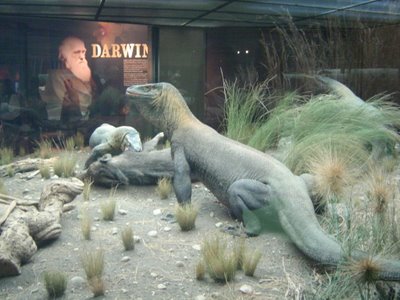Museums
On Thursday, I went to see the Darwin exhibit at the American Museum of Natural History, before meeting other teacher-blogger types in Central Park for a picnic. I already knew a lot of the material that the exhibit covered, though it is always cool to see original documents and speciments. One thing that struck me was how young Charles Darwin was when invited to join the Beagle expedition: he was only 22 years old, and very much still dependent on his father for permission and financial support. His father thought the trip was inappropriate and dangerous and would not have let him go if it weren't for Darwin's uncle Josiah intervening to support the idea. The Beagle trip lasted five years. When I was 22, I moved to NYC to begin teaching, and have been here for going on six years. Darwin spent the equivalent time period in his life aboard the Beagle. It's such a formative time period, striking out on one's own, leaving university and differentiating from one's parents. By the time he returned to England, his correspondence and specimens, sent home ahead of him, had already prepared a place for him among the respected scientists of the day. Talk about a coming of age story.

And then on Friday, I headed downtown to scout out museums for a field trip in June. We're taking the sixth graders sailing on the Pioneer, but it's going to be a long day because we have to split them up into three groups for the sails, and we need activities for them to do when not at sea... I visited the Museum of the American Indian, the Museum of American Financial History, and Fraunces Tavern. I got museumed-out before I had a chance to check out the Skyscraper Museum.

I was most impressed by the Museum of the American Indian, which is a part of the Smithsonian and is housed in a beautiful, grandiose Beaux-Arts building.

Right now, they have an exhibit of Native American pottery from all over the Americas, from thousands of years ago to the present. The pieces are fascinating and the explanation provided is interesting and helpful. The Museum took special care to include voices of Native American potters in the exhibit, and to involve them in the curation of the show. This worked really well. The presence of pieces made in the last few years, by living artists, highlighted the fact that the older objects were also pieces of artwork made by individuals who made artistic choices. And the presence of the older pieces highlighted the continuity of this tradition going back thousands of years. If that makes any sense.

The jar below is supposed to represent a hungry, open-mouthed baby bird. Cool, huh?


And then on Friday, I headed downtown to scout out museums for a field trip in June. We're taking the sixth graders sailing on the Pioneer, but it's going to be a long day because we have to split them up into three groups for the sails, and we need activities for them to do when not at sea... I visited the Museum of the American Indian, the Museum of American Financial History, and Fraunces Tavern. I got museumed-out before I had a chance to check out the Skyscraper Museum.

I was most impressed by the Museum of the American Indian, which is a part of the Smithsonian and is housed in a beautiful, grandiose Beaux-Arts building.

Right now, they have an exhibit of Native American pottery from all over the Americas, from thousands of years ago to the present. The pieces are fascinating and the explanation provided is interesting and helpful. The Museum took special care to include voices of Native American potters in the exhibit, and to involve them in the curation of the show. This worked really well. The presence of pieces made in the last few years, by living artists, highlighted the fact that the older objects were also pieces of artwork made by individuals who made artistic choices. And the presence of the older pieces highlighted the continuity of this tradition going back thousands of years. If that makes any sense.

The jar below is supposed to represent a hungry, open-mouthed baby bird. Cool, huh?







4 Comments:
What bakes my noodle about Chuck D (whoa! I didn't realize that until I typed it!) is you can cruise around the Galapogos and see the exact same tortoises that Chuck saw. The same ones. Man.
I'll be coming to NYC in May and I'll come to see the Darwin exhibit on May 26th - three days before closing! Almost a near-miss! I am excited and so are my kids.
I think they've extended the exhibit until August. Either way, glad you can make it!
If you are into reading about scientists, I'd recommend Patrick O'Brians bio about Joseph Banks (He went with Capt. James Cook on one or two of Cooks voyages....and for fun and adventure, there are several reads about Roy Chapman Andrews, authored by RCA himself, about his adventures in fossil hunting in the Gobi Desert in 1920's China.
There is also an exhibit making the rounds featuring Bog Mummies from Europe. I think it is at the Los Angeles County Nat. Hist. Museum right now.....
Post a Comment
<< Home